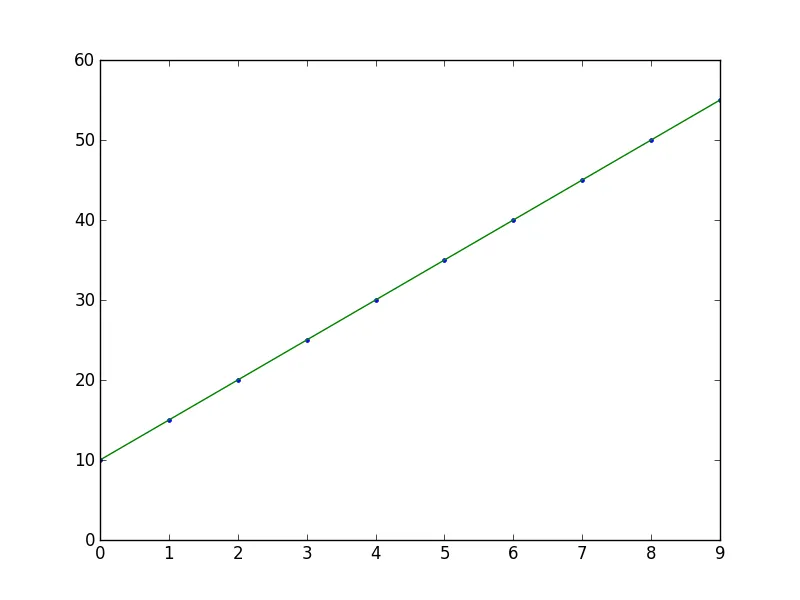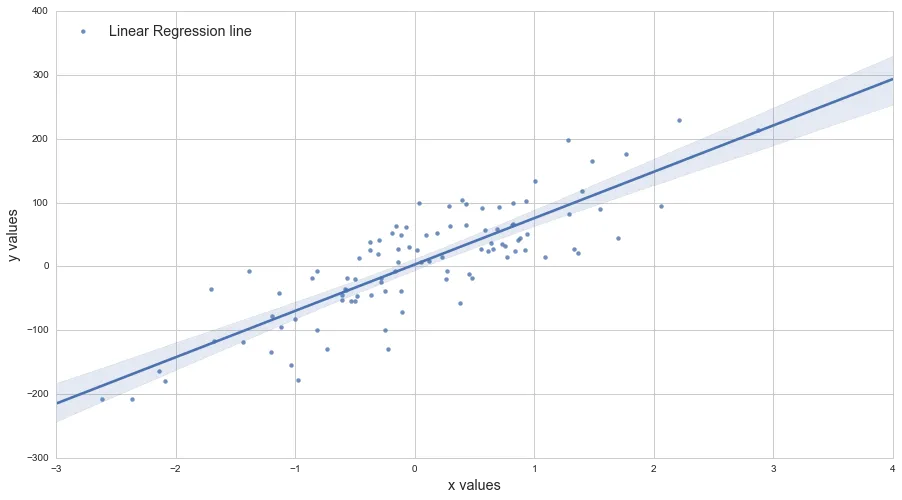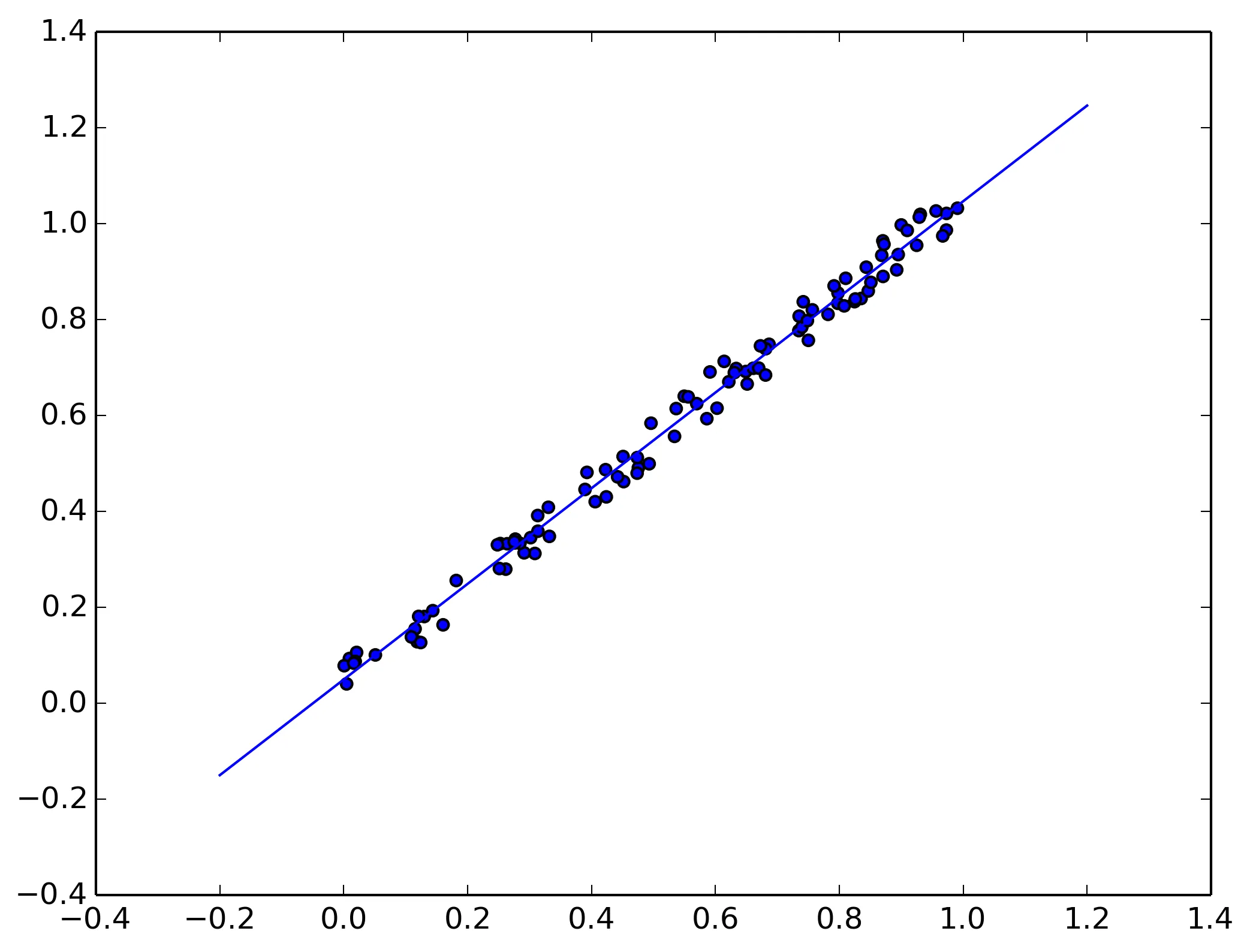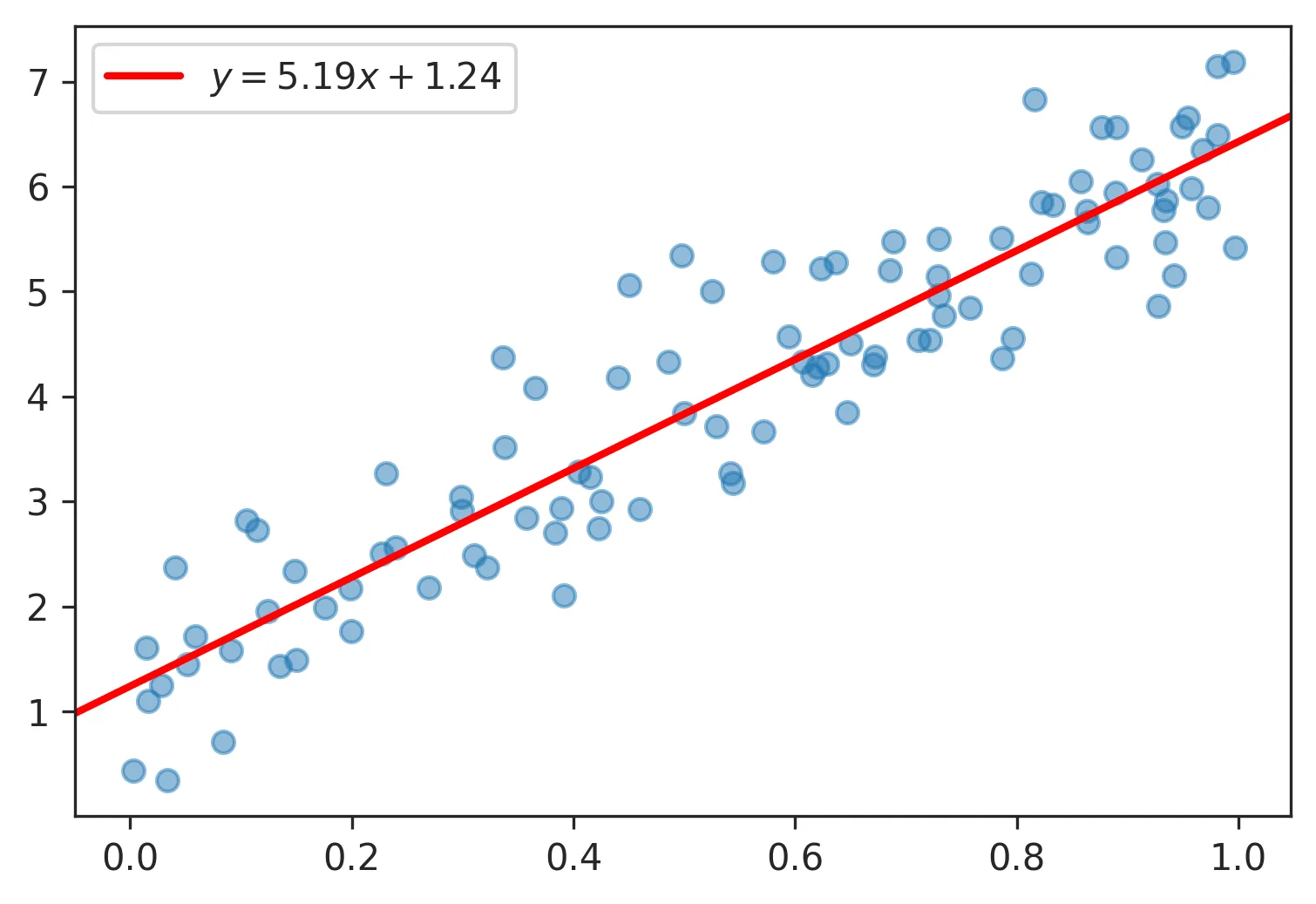我有两个数据向量,并将它们放入pyplot.scatter()中。现在我想要在这些数据上面画一个线性拟合。我该怎么做?我尝试使用scikitlearn和np.polyfit()。
如何在Python中的散点图上添加一条线?
82
- goldisfine
8个回答
148
import numpy as np
from numpy.polynomial.polynomial import polyfit
import matplotlib.pyplot as plt
# Sample data
x = np.arange(10)
y = 5 * x + 10
# Fit with polyfit
b, m = polyfit(x, y, 1)
plt.plot(x, y, '.')
plt.plot(x, b + m * x, '-')
plt.show()

- Greg Whittier
2
36
我偏爱scikits.statsmodels。这里有一个例子:
import statsmodels.api as sm
import numpy as np
import matplotlib.pyplot as plt
X = np.random.rand(100)
Y = X + np.random.rand(100)*0.1
results = sm.OLS(Y,sm.add_constant(X)).fit()
print(results.summary())
plt.scatter(X,Y)
X_plot = np.linspace(0,1,100)
plt.plot(X_plot, X_plot * results.params[1] + results.params[0])
plt.show()
唯一棘手的部分是 sm.add_constant(X),它会在X中添加一个值为1的列来得到拦截项。
Summary of Regression Results
=======================================
| Dependent Variable: ['y']|
| Model: OLS|
| Method: Least Squares|
| Date: Sat, 28 Sep 2013|
| Time: 09:22:59|
| # obs: 100.0|
| Df residuals: 98.0|
| Df model: 1.0|
==============================================================================
| coefficient std. error t-statistic prob. |
------------------------------------------------------------------------------
| x1 1.007 0.008466 118.9032 0.0000 |
| const 0.05165 0.005138 10.0515 0.0000 |
==============================================================================
| Models stats Residual stats |
------------------------------------------------------------------------------
| R-squared: 0.9931 Durbin-Watson: 1.484 |
| Adjusted R-squared: 0.9930 Omnibus: 12.16 |
| F-statistic: 1.414e+04 Prob(Omnibus): 0.002294 |
| Prob (F-statistic): 9.137e-108 JB: 0.6818 |
| Log likelihood: 223.8 Prob(JB): 0.7111 |
| AIC criterion: -443.7 Skew: -0.2064 |
| BIC criterion: -438.5 Kurtosis: 2.048 |
------------------------------------------------------------------------------

- pcoving
3
4我的身材看起来不同了;线条放错位置了;在这些点的上方。 - capybaralet
4@David: 参数数组的顺序错了。尝试使用以下方式:plt.plot(X_plot, X_plot * results.params[1] + results.params[0])。或者更好的方法是:plt.plot(X,results.fittedvalues),因为第一个公式假定y是x的线性关系,在这里确实是正确的,但并非总是如此。 - Ian
你创建的线性空间不一定会落在[0, 1]之间。 - undefined
28
- 1''
2
1嗨,我的x和y值是使用
numpy.asarray从列表转换而来的数组。当我添加这行代码时,我的散点图上出现了多条线,而不是一条。可能的原因是什么? - artre1@artre 感谢您提出这个问题。如果
x 没有排序或存在重复的值,可能会发生这种情况。我已经编辑了答案。 - 1''13
另一种方法是使用 axes.get_xlim():
import matplotlib.pyplot as plt
import numpy as np
def scatter_plot_with_correlation_line(x, y, graph_filepath):
'''
https://dev59.com/mmIk5IYBdhLWcg3wrvy4#34571821
x does not have to be ordered.
'''
# Create scatter plot
plt.scatter(x, y)
# Add correlation line
axes = plt.gca()
m, b = np.polyfit(x, y, 1)
X_plot = np.linspace(axes.get_xlim()[0],axes.get_xlim()[1],100)
plt.plot(X_plot, m*X_plot + b, '-')
# Save figure
plt.savefig(graph_filepath, dpi=300, format='png', bbox_inches='tight')
def main():
# Data
x = np.random.rand(100)
y = x + np.random.rand(100)*0.1
# Plot
scatter_plot_with_correlation_line(x, y, 'scatter_plot.png')
if __name__ == "__main__":
main()
#cProfile.run('main()') # if you want to do some profiling
- Franck Dernoncourt
9
matplotlib 3.3 新特性
使用新的plt.axline绘制直线,公式为y = m*x + b,其中m为斜率,b为截距:
plt.axline(xy1=(0, b), slope=m)
使用 plt.axline 的示例与 np.polyfit :
import numpy as np
import matplotlib.pyplot as plt
# generate random vectors
rng = np.random.default_rng(0)
x = rng.random(100)
y = 5*x + rng.rayleigh(1, x.shape)
plt.scatter(x, y, alpha=0.5)
# compute slope m and intercept b
m, b = np.polyfit(x, y, deg=1)
# plot fitted y = m*x + b
plt.axline(xy1=(0, b), slope=m, color='r', label=f'$y = {m:.2f}x {b:+.2f}$')
plt.legend()
plt.show()
在这里,方程式是一个图例条目,但如果您想沿着线绘制方程式,请参见如何旋转注释以匹配线条。
- tdy
3
plt.plot(X_plot, X_plot*results.params[0] + results.params[1])
对比
plt.plot(X_plot, X_plot*results.params[1] + results.params[0])
- Sébastien
2
你可以使用Adarsh Menon的教程,链接如下:https://towardsdatascience.com/linear-regression-in-6-lines-of-python-5e1d0cd05b8d。这是我发现的最简单的方法,基本上看起来像这样:
import numpy as np
import matplotlib.pyplot as plt # To visualize
import pandas as pd # To read data
from sklearn.linear_model import LinearRegression
data = pd.read_csv('data.csv') # load data set
X = data.iloc[:, 0].values.reshape(-1, 1) # values converts it into a numpy array
Y = data.iloc[:, 1].values.reshape(-1, 1) # -1 means that calculate the dimension of rows, but have 1 column
linear_regressor = LinearRegression() # create object for the class
linear_regressor.fit(X, Y) # perform linear regression
Y_pred = linear_regressor.predict(X) # make predictions
plt.scatter(X, Y)
plt.plot(X, Y_pred, color='red')
plt.show()
- plnnvkv
网页内容由stack overflow 提供, 点击上面的可以查看英文原文,
原文链接
原文链接



numpy.polyfit(x,y,deg,rcond = None,full = False,w = None,cov = False)[来源](https://docs.scipy.org/doc/numpy/reference/generated/numpy.polyfit.html)。 - Apollys supports Monica